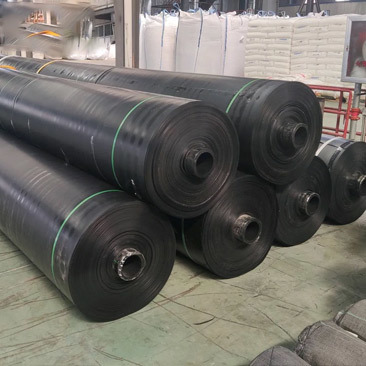Exploring the Benefits of Using PE Geomembrane in Construction
Release time:
2025-09-20
Exploring the Benefits of Using PE Geomembrane in Construction Table of Contents 1. Introduction to PE Geomembrane 2. What is PE Geomembrane? 3. Advantages of Using PE Geomembrane in Construction 3.1 Durability and Longevity 3.2 Cost-Effectiveness 3.3 Environmental Benefits 4. Applications of PE Geomembrane in Construction
Exploring the Benefits of Using PE Geomembrane in Construction
Table of Contents
- 1. Introduction to PE Geomembrane
- 2. What is PE Geomembrane?
- 3. Advantages of Using PE Geomembrane in Construction
- 4. Applications of PE Geomembrane in Construction
- 5. Installation and Maintenance of PE Geomembrane
- 6. Case Studies: Successful Implementation of PE Geomembrane
- 7. Frequently Asked Questions about PE Geomembrane
- 8. Conclusion
1. Introduction to PE Geomembrane
In the ever-evolving world of construction and civil engineering, the use of advanced materials is pivotal in ensuring project success. Among these materials, **Polyethylene (PE) geomembrane** stands out for its remarkable properties. As we delve into the benefits of using PE geomembrane, we will uncover how its application can lead to enhanced efficiency, safety, and sustainability in various construction projects.
2. What is PE Geomembrane?
PE geomembrane is a synthetic membrane liner made primarily from polyethylene, designed to act as a barrier to liquids and gases. Its impermeable properties make it a go-to solution for numerous applications in construction, including waste containment, water management, and mining operations. The geomembrane is manufactured in various thicknesses, with specific formulations tailored for different environmental conditions and project requirements.
3. Advantages of Using PE Geomembrane in Construction
The advantages of incorporating PE geomembrane into construction projects are multifaceted. Understanding these benefits can help stakeholders make informed decisions for their projects.
3.1 Durability and Longevity
One of the standout features of PE geomembrane is its **exceptional durability**. Manufactured from high-density polyethylene (HDPE) or linear low-density polyethylene (LLDPE), these geomembranes are resistant to punctures, tears, and degradation from UV rays. This resilience ensures that geomembranes maintain their integrity over time, significantly extending the lifespan of constructed facilities.
3.2 Cost-Effectiveness
Investing in PE geomembrane may seem daunting at first, but the long-term savings are substantial. The durability of these materials translates to less frequent replacements and repairs, reducing overall maintenance costs. Furthermore, the ease of installation minimizes labor costs, positioning PE geomembrane as a **cost-effective solution** for various applications.
3.3 Environmental Benefits
Sustainability is a key concern in contemporary construction practices. PE geomembrane plays a crucial role in protecting the environment by preventing the contamination of soil and groundwater. Its impermeable nature ensures that hazardous materials do not leach into the surrounding ecosystem, making it an essential component in **environmentally responsible construction**.
4. Applications of PE Geomembrane in Construction
The versatility of PE geomembrane extends to a wide array of applications in construction. Below are some of the most significant areas where PE geomembrane is utilized.
4.1 Landfills and Waste Management
PE geomembranes are widely used in landfill projects to create liners and caps that prevent leachate and gases from escaping. This application not only helps in managing waste effectively but also mitigates significant environmental hazards associated with landfill operations.
4.2 Water Containment Systems
In water management applications, PE geomembrane serves as an effective lining material for reservoirs, ponds, and canals. Its impermeable nature ensures that water does not seep into the ground, thus preserving valuable water resources. This application is particularly vital in areas prone to drought or where water conservation is a priority.
4.3 Mining Applications
The mining industry utilizes PE geomembrane for various purposes, including tailings storage facilities and heap leaching operations. The geomembranes provide reliable containment for hazardous materials, ensuring the safety of both the environment and the surrounding communities.
5. Installation and Maintenance of PE Geomembrane
Proper installation is crucial to harnessing the full benefits of PE geomembrane. Installation typically involves site preparation, laying out the geomembrane, and securing it in place. Regular inspections and maintenance, such as checking for punctures or tears, are essential to ensure the geomembrane continues to function correctly over time.
6. Case Studies: Successful Implementation of PE Geomembrane
A myriad of successful case studies highlights the effectiveness of PE geomembrane in various construction projects. One notable example is the implementation of PE geomembrane in a large-scale landfill project, which significantly reduced leachate generation and improved the overall efficiency of waste management practices. Similarly, several mining companies have reported enhanced safety and reduced environmental impact due to the use of PE geomembranes.
7. Frequently Asked Questions about PE Geomembrane
1. What is the lifespan of PE geomembrane?
The lifespan of PE geomembrane can vary based on environmental conditions and application, but it typically lasts over 30 years with proper installation and maintenance.
2. Is the installation of PE geomembrane complicated?
While installation requires expertise, it is generally straightforward. Proper site preparation and following manufacturer guidelines ensure a successful installation.
3. Can PE geomembrane be repaired if damaged?
Yes, PE geomembranes can be effectively repaired using specialized techniques and materials, ensuring continued performance.
4. What thickness of PE geomembrane is recommended for landfills?
Typically, a thickness of 60 mils (1.5 mm) or more is recommended for landfill applications to ensure durability and leak prevention.
5. Are there different types of PE geomembrane?
Yes, there are several types of PE geomembranes, including HDPE, LLDPE, and cross-linked polyethylene (XPE), each designed for specific applications and environments.
8. Conclusion
The use of **PE geomembrane** in construction presents numerous benefits, from enhanced durability and cost-effectiveness to significant environmental protection. With its versatile applications across various sectors, PE geomembrane stands as a critical material in modern construction practices. As we continue to embrace sustainable solutions, incorporating PE geomembrane not only safeguards the environment but also ensures project success in the long run. Embracing this advanced material will undoubtedly pave the way for safer, more efficient construction practices moving forward.






